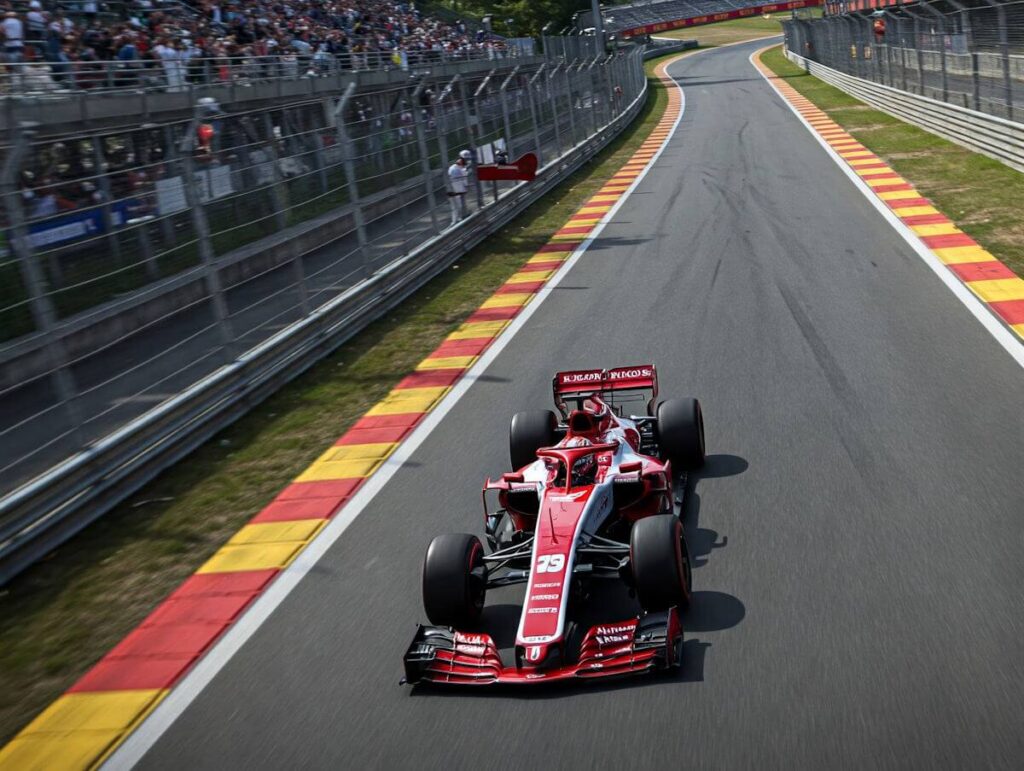F1 23 marks a significant advancement in the realm of racing simulations, building upon the successes of its predecessors while offering an unparalleled experience for both casual players and dedicated fans of the Formula 1 championship. This game is designed to replicate the intense thrill and precision of real-life racing, incorporating the latest technologies and more accurate dynamics that reflect the true essence of Formula 1 racing.
One of the most notable features of F1 23 is its authentic representation of the current Formula 1 season. The game includes all the official teams, drivers, and circuits, allowing players to dive deep into the world of motorsport as they compete in iconic races that have defined the sport. The developers have meticulously worked to ensure that the layout and characteristics of each track are faithfully recreated, contributing to a more immersive gaming experience. Players can expect to engage in races that demand not only speed but also strategic thinking and skillful navigation of challenging courses.
In addition to its fidelity to the real-world counterpart, F1 23 introduces several gameplay mechanics that enhance user interaction and responsiveness. New features such as advanced tire management systems and dynamic weather effects add layers of complexity and realism, allowing players to experience the challenges faced by professional drivers. The game also emphasizes the importance of precision and timing, rewarding those who master their racing lines and braking distances. With a range of modes, including time trials, championships, and multiplayer options, F1 23 offers gamers numerous pathways to enjoy the thrill of competitive racing.
The Evolution of F1 Racing Games
The realm of Formula 1 racing games has undergone a remarkable transformation since their inception, significantly influenced by advancements in technology. The journey began in the early 1990s, with titles that showcased rudimentary graphics and basic gameplay mechanics. These early iterations offered a glimpse into the excitement of Formula 1 racing but lacked the depth and realism that modern players now expect.
As technology advanced, so too did the capabilities of racing games. The introduction of 3D graphics in the mid-1990s revolutionized the visual experience, allowing players to immerse themselves in lifelike circuits and beautifully rendered cars. The release of games like “Formula 1” in 1996 for the PlayStation set a new standard, featuring improved physics and a more sophisticated artificial intelligence (AI) that began to mimic the competitive nature of real-life racing.
With each passing generation of gaming consoles, Formula 1 racing games have continued to evolve. The implementation of motion capture technology provided developers with the ability to create realistic driver animations, enhancing the games’ overall authenticity. The arrival of online multiplayer modes further elevated the experience, allowing players to compete against one another globally, fostering a sense of camaraderie and rivalry.
Key milestones in the Formula 1 gaming series are evident through various titles leading up to F1 23. Each new release has introduced refined physics engines, which replicate real-world car handling and tire behavior more accurately than ever before. Furthermore, dynamic weather systems and intricate circuit details have become standard, enriching the driving experience. The latest installment, F1 23, exemplifies this evolution, showcasing stunning graphics, advanced AI behavior, and gameplay that captures the essence of Formula 1 racing.
Game Features and Improvements
F1 23 represents a significant advancement in the Formula 1 racing simulation genre, showcasing a plethora of features and improvements that enhance both the visual fidelity and gameplay mechanics. One of the most noticeable upgrades is in the graphics department. The developers have leveraged state-of-the-art rendering techniques to deliver stunning racetracks and vehicle models that closely resemble their real-life counterparts. Improved lighting effects and dynamic weather conditions not only elevate the immersive experience but also influence racing performance, necessitating strategic adjustments from players.
Another major enhancement lies in the handling mechanics of the vehicles. The driving experience has been refined to provide players with greater control and realism. The introduction of a more sophisticated tire management system adds another layer of depth to racing strategy. Gamers are now required to maintain an awareness of tire degradation, adjusting their driving style and pit strategies accordingly. This new feature emphasizes the importance of tire selection and management during various race conditions, echoing the real-life challenges faced by F1 teams.
Furthermore, the track designs have seen notable improvements in F1 23. Each circuit is meticulously recreated, with more accurate elevation changes, track surfaces, and obstacles that mimic actual F1 races. Enhanced AI has also been integrated, ensuring that rival drivers behave more realistically, presenting both challenges and opportunities during races. Players can expect diverse racing strategies to emerge as they adapt to different AI driving styles. These advancements in graphics, handling, and track design collectively contribute to a more authentic racing experience, fostering strategic thinking and enhancing player engagement.
The Precision Racing Experience
The essence of precision racing in F1 23 lies in the meticulous attention to detail that each driver must exhibit when navigating the virtual circuits. This notion of accuracy is not merely about going fast; it significantly encompasses the subtleties that define successful driving techniques. Players must master the intricate balance between speed and control, ensuring that every turn, acceleration, and braking point is executed flawlessly. Achieving precision racing necessitates a deep understanding of the car’s behavior under various conditions, which is simulated impressively in F1 23.
One of the core components of this experience is the car setup, which directly influences handling characteristics and performance. Players can tailor aspects such as suspension stiffness, aerodynamics, and tire pressure to create a setup that aligns with their unique driving style and the track’s specific demands. This level of customization helps users to not just replicate, but enhance their racing efficacy by adapting to minute changes in track conditions or weather. The relationships between these factors necessitate a keen analytical ability and precision in adjustments, mirroring the real-world challenges faced by professional F1 teams.
Moreover, achieving precise racing is supported by practicing key techniques such as throttle control, braking points, and cornering strategies. Gamers can cultivate their skills through repeated trials and analysis of their performance metrics, thereby replicating the rigorous training routines that real-world drivers undergo. Simple maneuvers, like perfecting the racing line and optimizing entry and exit speeds of corners, can drastically improve lap times. As players delve deeper into the world of F1 23, they engage with racing dynamics that not only enhance their gaming experience but also bridge the gap between virtual racing and the tangible excitement of real Formula 1 racing.
Multiplayer and Community Engagement
The multiplayer features of F1 23 significantly enhance the gaming experience, allowing players to engage in exhilarating online racing competitions. The competitive nature of the game is amplified through its robust multiplayer modes, where players can race against friends or compete with others from around the world. This direct competition creates an electrifying environment that mimics the real-world excitement of Formula 1 racing.
One of the key elements of multiplayer engagement in F1 23 is the ability to join or create leagues. Players can form teams with friends or acquaintances, fostering camaraderie and a sense of community. These leagues not only add a layer of personalization to the gaming experience but also encourage regular interaction among players, resulting in a vibrant community atmosphere. Regular league races keep players engaged, as they strive for improvement and seek to outperform their rivals throughout the season.
Furthermore, F1 23 includes various community events that players can participate in to showcase their skills. These events often feature unique challenges that require strategic thinking and precision driving, appealing to both casual and competitive players alike. Such initiatives help cultivate a sense of belonging within the gaming community, as participants share their experiences and achievements on social media platforms.
The inclusion of rich multiplayer and community engagement features in F1 23 is a testament to the game’s commitment to providing an authentic racing experience. Players not only refine their driving skills but also bond with others who share their passion for motorsport. This comprehensive approach to multiplayer interactions not only enhances enjoyment but also fosters a competitive atmosphere reminiscent of actual Formula 1 races, making F1 23 a standout title in the racing genre.
The Role of AI in F1 23
In the ever-evolving landscape of racing simulation games, F1 23 stands out due to its significant advancements in artificial intelligence (AI). The introduction of enhanced AI drivers in this installment has transformed the gaming experience, providing players with a more immersive and competitive environment. Unlike previous iterations, the AI in F1 23 exhibits refined behaviors that replicate real-life racing strategies, making it a formidable opponent on the virtual track.
One of the notable improvements in F1 23 is the AI’s ability to adapt to various racing conditions. The algorithm implemented in this version allows AI drivers to modify their strategies based on laps completed, tire wear, and weather changes. This dynamic response creates a natural flow within races, as players must not only focus on their performance but also anticipate the moves of their AI competitors. The complexity of the AI behavior helps simulate the unpredictability of real-world racing, enhancing the overall depth of the gameplay experience.
Moreover, the AI in F1 23 employs a comprehensive strategy framework, which influences the decisions made by virtual drivers during the race. This includes when to pit, which tires to choose, and how to manage fuel efficiently. Such strategic elements are essential in maintaining a competitive edge against both AI and human players, thereby enriching the competitive dynamics on the track. The incorporation of machine learning techniques also contributes to the realism, as AI drivers learn from player actions and continuously refine their performance over time.
Ultimately, the advancements in AI technology in F1 23 not only heighten the challenge for seasoned racers but also accommodate newcomers seeking to improve their skills. By providing a realistic and strategic racing environment, the AI innovations serve as a critical element in delivering a thrilling experience that respects the intricacies of precision racing.
Realism vs. Accessibility
The evolution of racing simulations has always hinged on the balance between realism and accessibility, a challenge acutely present in F1 23. Developers are increasingly aware that catering to a diverse audience is crucial, from hardcore racing enthusiasts who seek an authentic experience, to casual gamers who prioritize ease of play. In F1 23, this balance is meticulously crafted through various gameplay features designed to enhance the user experience without sacrificing the core essence of precision racing.
One of the foundational elements contributing to this equilibrium is the implementation of adjustable difficulty settings. Players can tailor their experience to suit their individual skill levels, allowing seasoned racers to engage deeply with complex mechanics while offering novice players a more forgiving environment. This customization fosters a sense of progression; novices can gradually learn the intricacies of racing, while veterans can test their skills against advanced parameters that demand precision and strategy.
Tutorial options further exemplify the commitment to accessibility in F1 23. Comprehensive tutorials introduce players to essential gameplay mechanics, ensuring that users of all skill levels can familiarize themselves with the controls, track navigation, and race strategies. This educational approach not only strengthens the gameplay experience but also builds confidence among players who may be intimidated by the technicalities of racing simulations.
Additionally, gameplay modes designed for varied experiences, such as time trials and single-player championships, allow players to choose how they engage with the game. This flexibility not only caters to different gaming preferences but also reinforces the idea that racing can be both an immersive simulation and an entertaining pastime. By putting effort into these aspects, F1 23 strikes a harmonious balance that makes precision racing accessible to a broader audience, ultimately enhancing the game’s appeal and longevity.
Future of F1 Gaming
As the gaming landscape continues to evolve, the future of Formula 1 gaming promises to be an exciting journey filled with technological advancements and innovative gameplay mechanics. One of the most noteworthy developments on the horizon is the incorporation of enhanced artificial intelligence (AI) systems. These systems are set to create a more dynamic racing environment, adapting the behavior of AI competitors to provide a more realistic and challenging experience for players. The objective is to simulate the unpredictability of real-life racing, allowing gamers to engage with the sport in a more immersive way.
Furthermore, the integration of virtual reality (VR) has the potential to redefine how enthusiasts interact with F1 games. By allowing players to step into the cockpit of their favorite cars and experience races from a first-person perspective, VR can elevate the realism of the racing experience significantly. This technological shift aligns with the industry’s growing trend toward providing more immersive environments that engage players beyond traditional two-dimensional screens.
In addition to technological innovations, the gameplay features of future F1 titles may also witness profound changes. For instance, the implementation of robust online multiplayer modes could promote increased competition and community interaction. This feature is essential as online gaming continues to flourish, with players seeking thrilling competitive experiences that mirror the intensity of real-world racing.
Moreover, the shift towards expanding customization options will likely be a focal point. Allowing players to modify car aesthetics and performance dynamically not only enhances player engagement but also adds a layer of personal investment in the game. Trends in the gaming industry suggest that personalization, community-driven content creation, and expanding esports presence will shape future iterations of Formula 1 racing games.
As we look ahead, these advancements signal a promising future for not only the F1 franchise but the racing game genre overall. Continuous innovation and adaptation will remain critical to meet the expectations of an increasingly sophisticated gaming audience.
Conclusion and Final Thoughts
In summarizing the critical elements discussed throughout this blog post, it is evident that F1 23 stands as a pinnacle of excellence in racing simulations. The game not only showcases the intricate details of the Formula 1 environment but also emphasizes the importance of precision in racing. This attention to detail enhances the gaming experience and mirrors the actual dynamics faced by professional drivers on the circuit.
The advancements in technology incorporated into F1 23, such as refined physics engines and accurate vehicle performance modeling, significantly contribute to the realism that enthusiasts of the sport appreciate. These features enable players to engage in an immersive experience that challenges them to improve their driving skills and understand the nuances of precision racing. The game’s design inherently promotes a deeper connection between players and the sport, allowing gamers to experience the thrill and intricacies of Formula 1 racing firsthand.
Moreover, the community surrounding F1 23 plays a vital role in fostering engagement among both gamers and fans. Online multiplayer modes and collaborative events provide platforms for interaction, enabling players to share strategies and build friendships through a mutual passion for racing. This connectivity not only enriches the gaming experience but also cultivates a supportive environment for those who are new to the world of Formula 1.
Ultimately, F1 23 is more than just a game; it serves as a bridge connecting gamers with the exhilarating world of motorsport. As it continues to evolve, it promises to push the boundaries of racing simulations and redefine the standards for accuracy and engagement in the genre. Thus, players are encouraged to not only participate in the game but also involve themselves within the broader Formula 1 community, embracing the spirit of precision racing that defines this unparalleled sport.





